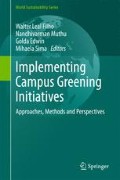Abstract
A huge quantity of organic food wastes generated in educational campuses goes unutilized and gets disposed of in landfills, despite the tremendous potential to turn the on-campus waste mis-management into a profitable and sustainable venture. The vision of green campus initiative at Jawahar Navodhaya Vidhyalaya (JNV) is to transform itself into a model for a self-sufficient campus. To foster this initiative, we envisaged a system of highly evolved, self-sufficient strategies not only to sustain the needs of the campus but also to reduce costs and generate income through integrated sustainable projects. The project is carried out through a cooperative effort among Pondicherry University researchers and APSCC’s strategic green action plan team for campus sustainability, focused on the campus’s commitment towards sustainability encompassing social equity, environmental management, and economic prosperity in tune with the Principles of Agenda 21 and Millennium Development Goals. The Campus biogas generation project is one such unique attempt which has prompted the JNV campus community to ponder over the causes of significant socio-environmental problems, and subsequently make an attempt to solve them through collaborative effort using scientific processes. This study involved rigorous field visits with observational study, building prototypes to try out various possible alternatives, hoping to arrive at an optimum solution by comparing different experimental models, field work, research and innovative ideas. The goal of the study is to foster student’s experience and learning along with research and planning for reducing fuel consumption through biogas production from organic waste generated within the campus. It is found that by adopting a 7 m3 Antirotatory-anaerobic Baffled Co-coupled Double-digester (ABCD-hybrid) model of an anaerobic digester, enough biogas is produced to replace approximately 6.2 LPG cylinders/month with the potential reduction in petroleum gas of 10.34 % and saving of around INR 7,864 per month.
Access this chapter
Tax calculation will be finalised at checkout
Purchases are for personal use only
References
Amon T, Amon B, Kryvoruchko V, Bodiroza V, Pötsch E, Zollitsch W (2006) Optimising methane yield from anaerobic digestion of manure: effects of dairy systems and of glycerine supplementation. Int Cong Ser 1293:217–220
Armijo de Vega C, Ojeda Benitez S, Ramirez Barreto ME (2008) Solid waste characterization and recycling potential for a university campus. Waste Management, 28. Supplement I:S21–S26
Bolzonella D, Pavan P, Mace S, Cecchi F (2005) Dry anaerobic digestion of differently sorted organic municipal solid waste: a full scale experience. In: 4th international symposium of anaerobic digestion of solid waste (Copenhagen–Denmark) 1:85–92
Bouallagui H, Touhami Y, Ben Cheikh R, Hamdi M (2005) Bioreactor performance in anaerobic digestion of fruit and vegetable wastes. Proc Biochem 40:989–995
Callaghan FJ, Wase DAJ, Thayanithy K, Forster CF (1999) Co-digestion of waste organic solids: batch studies. Bioresour Technol 67:117–122
Danielle PS, Arthur LF, Annie LB (2010) Reducing solid waste in higher education: the first step towards ‘greening’ a university campus. Resour Conserv Recycl 54(11):1007–1016
Frankin R (2001) Full-scale experiences with anaerobic treatment of industrial wastewater. Water Sci Technol 44(8):1–6.
Jantsch TG, Mattiason B (2004) An automated spectropphoyometric system for monitoring buffer capacity in anaerobic digestion processes. Water Res 38:3645–3650
Kullavanijaya P, Thongduang P (2012) Enhanced biogas production in anaerobic digestion of cassava wastewater though supplementation of biodiesel waste as co-substrate. Int J Renew Energy Res (IJRER) 2(3):510–515
Martinot E, Akanksha C, Moreira JR, Lew D, Wamukonya N (2002) Renewable energy markets in developing countries. Annu Rev Energy Env 27:309–348
Mata-Alvarez J, Macé S, Llabrés P (2000) Anaerobic digestion of solid wastes an overview of research achievements and perspectives. Bio Resour Technol 74:3–16
McGarry MG, Stainforth J (1978) Compost, fertilizer, and biogas production from human and farm wastes in the People’s Republic of China. International Development Research Centre, Ottawa
MSW (2000) http://www.cpcb.nic.in. Accessed on 15 Jan 2013
Nandhivarman M, Poyyamoli G, Golda AE (2011) Environmental sustainability—a conceptual frame work for Pondicherry University, Puducherry, India—a case study. In: Proceedings of the 11th international congress of Asian Planning Schools Association, Tokyo, Japan
Nandhivarman M, Edwin GA, Ramaswamy AP, Poyyamoli G (2012) Integrated organic kitchen waste management for campus sustainability—a case study of Pondicherry University, India. In: Sustainable development at universities: New Horizons. Peter Lang Publishers, Switzerland
Rao MS, Singh SP (2004) Bio energy conversion studies of organic fraction of MSW: kinetic studies and gas yield-organic loading relationships for process optimization. Bioresour Technol 95:173–185
Raven RPJM, Gregersen KH (2007) Biogas plants in Denmark: successes and setbacks. Renew Sustain Energy Rev 11:116–132
Roberts P (2005) The end of oil: the decline of the petroleum economy and the rise of the new energy order. Bloomsbury Publishing, London
Sasse L (1988) Biogas plants. A publication of the Deutsches Zentrum für Entwicklungstechnologien, GATE in: Deutsche Gesellschaft für Technische Zusammenarbeit (GTZ) GmbH-1988
Taleghani G, Kia AS (2005) Technical–economical analysis of the Saveh biogas power plant. Renew Energy 30:441–446
Tchobanoglous G, Theisen H, Vigil S (1996) Integrated solid waste management. McGraw-Hill, New York
US EPA (2010) Methane to markets international guidance for quantifying and reporting the performance of anaerobic digestion systems for livestock manures. https://www.globalmethane.org/documents/M2M_International_Guidance_for_AD_July2010.pdf. Accessed on 15 Jan 2013
Author information
Authors and Affiliations
Corresponding author
Editor information
Editors and Affiliations
Rights and permissions
Copyright information
© 2015 Springer International Publishing Switzerland
About this chapter
Cite this chapter
Nandhivarman, M., Poyyamoli, G., Edwin, G.A., Prasath, R.A., Boruah, D. (2015). Evolving and Implementing Energy Recovering Strategy from Food Wastes at Jawahar Navodaya Vidhyalaya (JNV) Fostering Campus Sustainability. In: Leal Filho, W., Muthu, N., Edwin, G., Sima, M. (eds) Implementing Campus Greening Initiatives. World Sustainability Series. Springer, Cham. https://doi.org/10.1007/978-3-319-11961-8_1
Download citation
DOI: https://doi.org/10.1007/978-3-319-11961-8_1
Published:
Publisher Name: Springer, Cham
Print ISBN: 978-3-319-11960-1
Online ISBN: 978-3-319-11961-8
eBook Packages: Earth and Environmental ScienceEarth and Environmental Science (R0)

